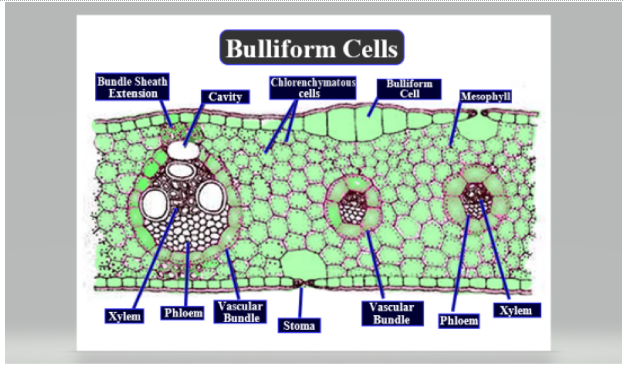
Bulliform or motor cells are present in
(a)Dicot stem
(b)Upper epidermis of dicot leaves
(c)Lower epidermis of monocot leaves
(d)Upper epidermis of monocots leaves
Answer
583.5k+ views
Hint: They are present in the grass and grass-like flowering plants. This is one layer of cells containing few or no chloroplasts. The cells are quite transparent and permit most of the light that strikes them to undergo the underlying cells.
Complete answer:
Bulliform cells or motor cells are present on the upper surface of the leaves of many monocots. They are large, bubble-shaped epidermal cells that occur in groups on the upper surface of the leaves of the many monocots. They are colourless as there are few or no chloroplasts. They have central vacuole filled with water. They are hygroscopic (water absorbing) in nature, they absorb water and store in the vacuoles. They have an important role in leaf folding and unfolding. Example- grasses (they are present on the upper surface of the grass (monocots).
Additional Information: During drought, the loss of water through vacuoles induces the reduced bulliform cells to permit the leaves of the many grass species to shut and the two edges of the grass blade fold toward each other. Once enough water is available, these cells enlarge and the leaves open again.
Folded leaves offer less exposure to sunlight, in order that they are heated less thus reducing evaporation and conserving the remaining water within the plant. Bulliform cells occur on the leaves of a large variety of monocotyledon families but are probably best known in grasses.

So, the correct answer is ‘Upper epidermis of monocots leaves’
Note: It is unclear if this mechanism applies in all monocots, however, or whether other components such as fibers are the pieces controlling the folding and unfolding of the leaf. What is observed is that the turgidity of the bulliform cells often coincide with the folding activity, though there are cases where folding happens long after the cells have gone turgid.
Complete answer:
Bulliform cells or motor cells are present on the upper surface of the leaves of many monocots. They are large, bubble-shaped epidermal cells that occur in groups on the upper surface of the leaves of the many monocots. They are colourless as there are few or no chloroplasts. They have central vacuole filled with water. They are hygroscopic (water absorbing) in nature, they absorb water and store in the vacuoles. They have an important role in leaf folding and unfolding. Example- grasses (they are present on the upper surface of the grass (monocots).
Additional Information: During drought, the loss of water through vacuoles induces the reduced bulliform cells to permit the leaves of the many grass species to shut and the two edges of the grass blade fold toward each other. Once enough water is available, these cells enlarge and the leaves open again.
Folded leaves offer less exposure to sunlight, in order that they are heated less thus reducing evaporation and conserving the remaining water within the plant. Bulliform cells occur on the leaves of a large variety of monocotyledon families but are probably best known in grasses.

So, the correct answer is ‘Upper epidermis of monocots leaves’
Note: It is unclear if this mechanism applies in all monocots, however, or whether other components such as fibers are the pieces controlling the folding and unfolding of the leaf. What is observed is that the turgidity of the bulliform cells often coincide with the folding activity, though there are cases where folding happens long after the cells have gone turgid.
Recently Updated Pages
The number of solutions in x in 02pi for which sqrt class 12 maths CBSE

Write any two methods of preparation of phenol Give class 12 chemistry CBSE

Differentiate between action potential and resting class 12 biology CBSE

Two plane mirrors arranged at right angles to each class 12 physics CBSE

Which of the following molecules is are chiral A I class 12 chemistry CBSE

Name different types of neurons and give one function class 12 biology CBSE

Trending doubts
What is 1s 2s 2p 3s 3p class 11 chemistry CBSE

Discuss the various forms of bacteria class 11 biology CBSE

Show that total energy of a freely falling body remains class 11 physics CBSE

Name the metals and nonmetals in the first twenty class 11 chemistry CBSE

Proton was discovered by A Thomson B Rutherford C Chadwick class 11 chemistry CBSE

Bond order ofO2 O2+ O2 and O22 is in order A O2 langle class 11 chemistry CBSE




